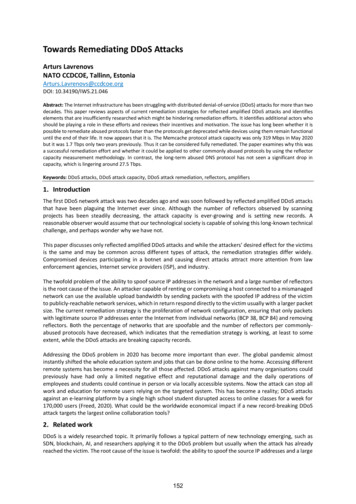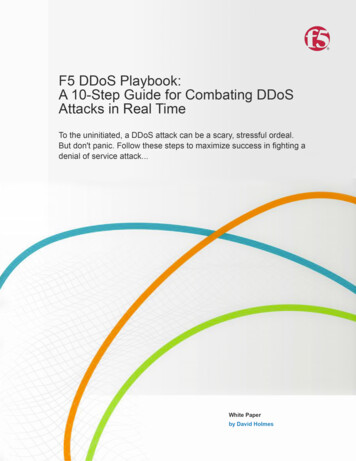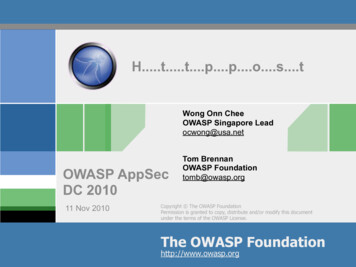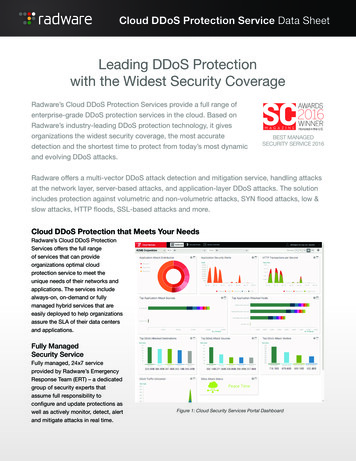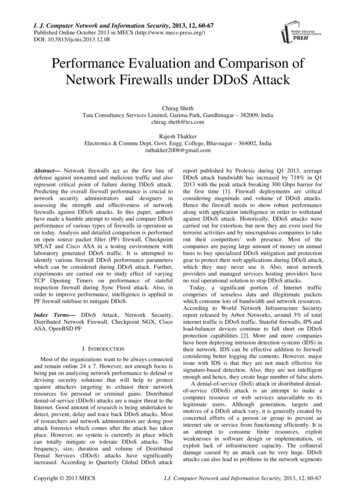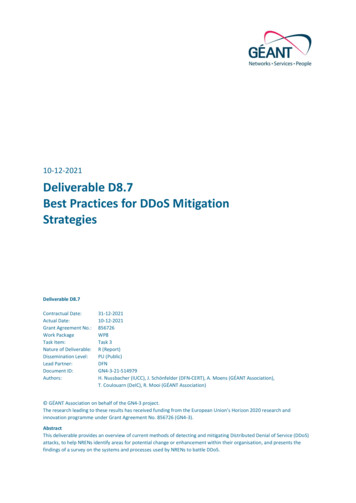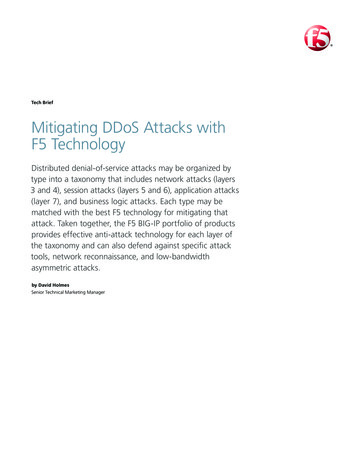
Transcription
Tech BriefMitigating DDoS Attacks withF5 TechnologyDistributed denial-of-service attacks may be organized bytype into a taxonomy that includes network attacks (layers3 and 4), session attacks (layers 5 and 6), application attacks(layer 7), and business logic attacks. Each type may bematched with the best F5 technology for mitigating thatattack. Taken together, the F5 BIG-IP portfolio of productsprovides effective anti-attack technology for each layer ofthe taxonomy and can also defend against specific attacktools, network reconnaissance, and low-bandwidthasymmetric attacks.by David HolmesSenior Technical Marketing Manager
Tech BriefMitigating DDoS Attacks with F5 TechnologyContentsIntroduction3PVA Processing5Full-Proxy Architecture6Protocol Validation6Repelling Specific Network Attacks7Mitigating Session AttacksMitigating Specific Session AttacksMitigating Application Attacks101012Mitigating Specific Application Attacks13Mitigating Low Bandwidth HTTP Attacks15Mitigating Attacks Using Network Reconnaissance17Mitigating Attacks on Business Logic18Conclusion192
Tech BriefMitigating DDoS Attacks with F5 TechnologyIntroductionIncreasing difficulty of attack detectionDistributed denial-of-service (DDoS) attack types have moved up the OSI networkmodel over time, climbing from network attacks in the 1990s to session attacks andapplication layer attacks today. Network attacks include DDoS variants such as SYNfloods, connection floods, or ICMP fragmentation. Session attacks, which targetlayers 5 and 6, include DNS and SSL attacks. Application attacks at layer 7 representapproximately half of all attacks today. Finally, though layer 7 tops the OSI model,attacks are now moving into business logic, which often exists as a layer above theOSI model. But even with these changes in the current threat spectrum, organizationsmust continue to defend against network and session attacks, too.ApplicationApplication AttacksPresentationSessionSession AttacksTransportNetworkNetwork AttacksData LinkPhysicalFigure 1: DDoS attacks target many layers of the OSI network model.Meanwhile, the Application Delivery Controller (ADC) has become a strategic pointof control in the network. ADCs can be both network- and application-aware andcan be managed by network, application, and security teams. Over time, ADCshave evolved into flexible, high-performance components of the network thatcan offload services such as load-balancing, caching, and acceleration to saveorganizations both CapEx and OpEx. In addition to consolidating performance,scalability, and flexibility solutions into a single platform immediately in front ofweb services, the ADC becomes a logical defensive position against both DDoSattacks and targeted application-layer attacks.Having occupied this position in many large enterprises and data centers for years,F5 ADC technologies have evolved to mitigate attacks targeting not only thenetwork but also the application and business logic levels.3
Tech BriefMitigating DDoS Attacks with F5 TechnologyIncreasing difficulty of attack detectionF5 solutions can securely deliver applications while protecting the network, thesession, and the user. Specific F5 mitigation technologies map directly to individualDDoS attacks for the network, the session, the application, and business logic.Effective security solutions involve core F5 products such as F5 BIG-IP Local TrafficManager (LTM) and BIG-IP Global Traffic Manager (GTM) as well as the newBIG-IP Advanced Firewall Manager (AFM). F5 iRules , a programmatic scriptinglanguage, can be easily adapted as a final, flexible security defense. Lastly, securityproducts like BIG-IP Application Security Manager (ASM), F5’s web applicationfirewall module, can block the most sophisticated attacks in the DDoS threatspectrum.AttackF5 Mitigation TechnologyApplicationOWASP Top 10 (SQLinjection, XSS, CSRF, etc.),Slowloris, Slow POST,HashDos, GET floodsBIG-IP ASM: Positive andnegative policy reinforcement,iRules, full proxy for HTTP,server performance anomalydetectionSessionDNS UDP floods,DNS query floods,DNS NXDOMAIN floods,SSL floods, SSLrenegotiationBIG-IP LTM and BIG-IP GTM:High scale performance,DNS Express, SSL termination,iRules, SSL renegotiationvalidationNetworkSYN floods, connectionfloods, UDP floods, PUSHand ACK floods, teardrop,ICMP floods, ping floods,and smurf attacksBIG-IP AFM: SYN Check, defaultdeny posture, high-capacityconnection table, full proxytraffic visibility, rate limiting,strict TCP forwardingFigure 2: Today’s attacks are moving up the OSI stack.4
Tech BriefMitigating DDoS Attacks with F5 TechnologyMitigating Network AttacksThe most basic network attacks attempt to overwhelm a defensive device with sheervolumes of traffic. Sometimes these volumetric attacks are designed to overload theconnections-per-second (CPS) capacity (e.g., the ramp-up rate). Another, slightlymore sophisticated attack method is to establish many legitimate connections (aconnection flood) to overwhelm the memory of any stateful defensive devices sothey lose the ability to accept legitimate connections. Attacks of both kinds aremitigated by the full-proxy position of BIG-IP LTM and its underlying F5 TMOS architecture, which deliver the intelligence to distinguish between legitimate andmalicious connections plus the capability to either absorb or drop the maliciousones before they consume network resources behind the device.Increasing difficulty of attack detectionThere are three key technologies within BIG-IP LTM that deliver its network defensefunctionality: F5 Packet Velocity Accelerator (PVA) processing, a full-proxyarchitecture, and protocol validation. Memory management and customconfiguration complement this trio of technologies to help organizations repelattacks.ApplicationApplication AttacksPresentationSessionSession AttacksTransportNetworkNetwork AttacksData LinkPhysicalFigure 3: Network attacks target layers 2 through 4.PVA ProcessingThe PVA is a purpose-built, customized hardware processor that assists BIG-IP LTMto scale by an order of magnitude above software-only solutions. PVA technology isfully session-aware and contains mitigation code for common network attacks suchas SYN floods.5
Tech BriefMitigating DDoS Attacks with F5 TechnologyFull-Proxy ArchitectureSolutions built atop a full-proxy architecture can be active security agents becausetheir architecture makes them part of the flow of traffic, not simply devicessampling that traffic. Products that are full proxies provide inherently better securitybecause they actively terminate the flow of data, essentially creating an “air gap”security model inside the product.With full proxies like BIG-IP LTM, traffic coming from the client can be examinedbefore it is sent on its way to the application tier, ensuring that malicious trafficnever passes the proxy barrier. Traffic returning from the server can be fullyexamined before it is deemed acceptable to pass back to the client, therebyensuring that sensitive data such as credit card or Social Security numbers arenever passed across the proxy barrier.Protocol ValidationA third method of network attack involves sending malformed data, such as packetswith invalid combinations of flags or incomplete fragments. These attacks can bevery effective because they tie up the CPU or memory of devices that examine them.Often the number of CPU cycles spent defending the packet dwarfs the processingthat it takes to launch the packet, leading this method to be known as anasymmetric attack.Client/ServerClient/ServerWeb ApplicationWeb workNetworkPhysicalPhysicalFigure 4: Because they actively terminate the flow of data, F5 full-proxy solutions provideinherently better security.6
Tech BriefMitigating DDoS Attacks with F5 TechnologySuch invalid data and asymmetric attacks are mitigated by the protocol validationtechnology of BIG-IP products. In protocol validation, the ADC understands theexpected network protocol of traffic destined for each application and can discardmalformed traffic before it penetrates deeper into the data center.Repelling Specific Network AttacksNetwork attacks, which have been around a long time, have evolved with impressivelongevity and variety. The BIG-IP product family mitigates a long list of networkattack types, most through built-in technologies or in default configurations.SYN floodsAn old attack and the most common network DDoS attack, the SYN flood exploitsthe three-way handshake of the TCP setup. Any device, including a firewall, thatterminates TCP is susceptible to the SYN flood attack unless specific measures aretaken to defend against it. Conventional firewalls mitigate this attack using differenttechnologies and with varying rates of success.Over time, three main mitigation techniques have evolved to combat SYN floods.The SYN proxy defense, found on many modern pass-through firewalls, stalls TCPconnections to filter out invalid ones. The drawback to this approach is that it onlyforestalls the problem and makes the firewall itself vulnerable to larger SYN floods.A second mitigation approach is the SYN cache. This technology, found mostly onserver platforms, relies on optimized memory tables to scale more connections.Results have been mixed, and the SYN cache approach is losing market traction.The third and best mitigation technique is called the SYN cookie approach. SYNcookies are encrypted sequence numbers that allow a defending device to filter outinvalid sessions without consuming any state information.The SYN cookie approach underlies the F5 SYN Check feature. The majority ofF5 devices include the PVA technology, either as an ASIC chip or set of fieldprogrammable gate arrays (FPGAs). For hardware-accelerated virtual servers, thePVA is the first line of defense against SYN floods. When a SYN flood is detected,the PVA turns on its SYN Check feature to prevent invalid sessions from gettingpast the PVA to the servers behind it.BIG-IP virtual editions (or any configuration that cannot take advantage of thehardware-assisted PVA technology) also benefit from the SYN Check feature. Thehigh-performance traffic management microkernel in the TMOS platform contains7
Tech BriefMitigating DDoS Attacks with F5 Technologya software version of SYN Check that uses high- and low-water marks to controlthe encrypted-cookie gating mechanism.Connection floodsAnother old, yet still common, attack is the TCP connection flood. This DDoS variantconsumes connection table resources for any stateful device between the perimeterand the target servers. The full-proxy nature of BIG-IP LTM protects data centerresources by accepting the DDoS connections and then using memory management,via its high-capacity connection table and aggressive connection reaping, to soak upconnection floods before they reach server resources.UDP floodsThe key to fast denial of UDP floods historically has been the default-deny securityposture. BIG-IP LTM provides this posture for the data plane. Any packets that do notmatch a defined virtual server are dropped as quickly as possible, thus mitigating UDPfloods. No UDP packets ever reach HTTP-based applications behind a BIG-IP device.Fake sessionsThe fake TCP session is a clever attack that often passes through conventionalfirewalls. It contains not just a proper-looking SYN packet but also a series of fakeTCP payload packets and even a closing packet. When BIG-IP LTM is in place, fakesession packets sent at a high volume are filtered out by its built-in SYN Checkfeature, while fake session attacks sent at low volume have their connectionsdropped when the ADC rejects the invalid sequence numbers.PUSH floods and ACK floodsA full-proxy ADC can mitigate PUSH and ACK floods. Because BIG-IP LTM is part ofevery conversation between every client and every server, it can recognize packetsthat do not belong to any valid flow, such as typical PUSH and ACK flood packets.These are dropped quickly and never pass beyond the ADC.ICMP floods, ping floods, and smurf attacksOne of the few layer 3 attacks still in use today is the ICMP flood. Often thesefloods are triggered by amplifying ICMP echo replies from a separate (and ofteninnocent) network to a target host. BIG-IP LTM mitigates ICMP floods by limitingthe rates of all ICMP traffic and then dropping all ICMP packets beyond the limit.The limit is adjustable by the operator.8
Tech BriefMitigating DDoS Attacks with F5 TechnologyPing of death ICMP attacksThe ping of death attack uses overly large ICMP packets to reboot vulnerable servers.These packets are denied at the BIG-IP LTM ADC in its default configuration. Only ifan operator enables the device’s ANY IP feature for the target virtual server will theADC allow these fragmented ICMP packets into the enterprise or data center.Christmas tree attacksA Christmas tree packet is one that is “gifted” with all of the possible TCP flagsenabled (such as SYN and RST, which is an illegal combination). Older devices becomeconfused by the packets, which leads to unpredictable behavior. When BIG-IP LTM’sstrict TCP forwarding option is configured, it rejects Christmas tree packets.LAND attacksLocal Area Network Denial (LAND) attacks use incoming packets whose sourceaddress is spoofed to match the ADC itself. BIG-IP LTM checks specifically for LANDattack packets and quickly drops them.Teardrop attacksThe teardrop attack exploits an overlapping IP fragment problem in some commonoperating systems. It causes the TCP reassembly code to improperly handleoverlapping IP fragments. In its default configuration, the BIG-IP system handlesthese attacks by correctly checking frame alignment and discarding improperlyaligned fragments. Teardrop packets are dropped and the attacks are mitigatedbefore the packets can pass into the data center.Layer 4 Security Management and VisibilityIn addition to readily defeating these common network attacks, the BIG-IP productfamily includes BIG-IP AFM, which enables security teams to manage security rulesets in the same way they might manage conventional firewall rules. Securityadministrators can use the BIG-IP AFM point-and-click interface to drop, allow, orlog incoming traffic using at the network level.BIG-IP AFM tracks 38 different types of network DDoS attacks (including all ofthose mentioned above) and reports on each. Organizations can also define theparameters of their own attack detection signatures and be alerted when thresholdsfor these are passed.9
Tech BriefMitigating DDoS Attacks with F5 TechnologyMitigating Session AttacksIncreasing difficulty of attack detectionSession attacks, which take place at layers 5 and 6, include DNS and SSL attacks.Conventional firewalls have no ability to mitigate SSL attacks and offer only limiteddefensive value for DNS attacks.ApplicationApplication AttacksPresentationSessionSession AttacksTransportNetworkNetwork AttacksData LinkPhysicalFigure 5: Session attacks typically defeat conventional firewalls.F5 products can defend DNS and SSL resources against session- and presentationlevel attacks. For both, the key to the defense is the high-performance, full-proxy F5functionality that validates and shapes every DNS and SSL connection between theInternet and the data center.The security services offered in BIG-IP GTM provide protection against DDoS attacksat the DNS security perimeter. BIG-IP LTM protects SSL resources by offloading SSLprocessing onto its high-performance, high-capacity hardware and throughjudicious use of iRules.Mitigating Specific Session AttacksSession attacks can be defeated through a combination of hardware capacity andtechnologies such as the proprietary features of F5 ADCs.DNS UDP floodsNormal DNS servers cannot withstand a typical distributed UDP flood. BIG-IP GTMmitigates UDP floods by scaling performance far beyond that of a normal DNS server.Since version 11.0, the full-proxy BIG-IP GTM validates each and every DNS requestpacket and discards those that are invalid (such as packets from a UDP flood).10
Tech BriefMitigating DDoS Attacks with F5 TechnologyDNS query floodsA more advanced DNS attack is the query attack, in which multiple clients flood thetarget with valid DNS requests, attempting to overload it. The F5 DNS Express feature in BIG-IP GTM can mitigate these attacks by enabling multi-core, linearscaling. DNS Express further protects the perimeter by handling all valid and invalidDNS requests itself, at a capacity up to an order of magnitude greater than a typicalDNS server.DNS NXDOMAIN floodsOne of the most sophisticated DNS attacks is the NXDOMAIN query flood, which isdesigned to foil DNS caches and bring down DNS servers. It works by causing DNSservers to spend their time looking for thousands or millions of nonexistent hostrecords. DNS Express is ideally suited to help an organization survive an NXDOMAINflood because it retains all the valid organization zone information even during theflood.SSL floodsOrganizations are starting to see more malicious floods of SSL connections cominginto their data centers. These SSL floods bypass firewalls, intrusion preventionsystem (IPS) perimeters, and cloud scrubbers, and they can take down serverresources or overflow stateful firewalls. By terminating SSL at a capable ADC, anorganization can stop SSL floods. A full proxy for SSL processing, such as BIG-IP LTM,simply drops malicious or empty SSL connections, protecting the resources behind itSSL renegotiation attacksThe notorious SSL renegotiation attack was discovered when it was initially launchedagainst an F5 customer, who was then assisted by the F5 field services team. Whatmakes this attack so effective is that it exploits the asymmetric encryption propertyof SSL, so the attacker needs only one-tenth of the computational power of theunprotected server. Still, the high capacity and performance of F5 hardware for SSLcryptographic offloading means that an SSL renegotiation attack has to beextremely strong to overcome a BIG-IP device.The original attack was repelled by a simple iRule now published on the F5 DevCentral online community. F5 still has one of the only solutions to this thornyprotocol attack. The premise of the iRule is that if a client connection attempts to11
Tech BriefMitigating DDoS Attacks with F5 Technologyrenegotiate more than five times in any 60-second period, that client connection issilently dropped.One of the benefits of this iRule and its silent work is that it fools the attacker intothinking the connection is merely stalled, fully negating the attack.If an organization is a frequent target or handles traffic that is a primarily SSL traffic,the following iRule can be deployed at every virtual server that requires protection.when RULE INIT {set static::maxquery 5set static::mseconds 60000}when CLIENT ACCEPTED {set ssl hs reqs 0}when CLIENTSSL HANDSHAKE {incr ssl hs reqsafter static::mseconds { if { ssl hs reqs 0}{incr ssl hs reqs -1} }if { ssl hs reqs static::maxquery } {after 5000log “Handshake attack detected, dropping[IP::client addr]:[TCP::client port]”drop}}Mitigating Application AttacksAt the top of the OSI stack is the application layer. This is the area where it’smost difficult to detect or defend against malicious behavior, and in particular,conventional firewalls provide little defensive value. Consequently, the applicationlayer is being targeted by most of today’s attackers.12
Increasing difficulty of attack detectionTech BriefMitigating DDoS Attacks with F5 TechnologyApplicationApplication AttacksPresentationSessionSession AttacksTransportNetworkNetwork AttacksData LinkPhysicalFigure 6: Application attacks are the most prevalent today.An application attack is different from a network attack in that it is specific to theapplication being targeted. Whereas a SYN flood can be launched against an IPaddress, an application attack will usually exploit properties specific to the victim,such as the repeated downloading of a single PDF file on the website. To lower-levelsecurity devices such as firewalls, the attack connections are indistinguishable fromnormal traffic.BIG-IP ASM brings together a variety of anti-attack and DDoS preventiontechnologies specifically designed to mitigate application layer attacks, includingthe majority of the OWASP Top 10. BIG-IP ASM learns the expected input for everypage in the site it protects and generates a security policy to protect that page.Because BIG-IP ASM is application-aware, it can foil application-layer attacks thatabuse the application, the database, or the business logic.BIG-IP ASM can distinguish between humans and robots as the sources of trafficand use this information during an attack to block non-human visitors. It can alsoinject JavaScript redirect code into the stream to foil the majority of botnet slaveswhile allowing access to legitimate browsers. Finally, BIG-IP ASM can also rate-limittraffic to specific application servers when it detects that an attack may beunderway.Mitigating Specific Application AttacksToday’s DDoS attack tools often use multiple attack vectors, mixing flood types.As attacks against the application layer increasingly grow multi-pronged, they’vesometimes earned the name diverse distributed denial-of-service (3DoS) attacks.Whether they use high- or low-bandwidth approaches or both, these attacks canbe very difficult to identify and defeat.13
Tech BriefMitigating DDoS Attacks with F5 TechnologyA solution that can provide early warning about the attack vectors and defendagainst multiple, simultaneous vectors is therefore the most effective. Thecombination of BIG-IP LTM, appropriate iRules, and BIG-IP ASM defeats a largenumber of application-layer attacks.OSI LayerAttackApplication(Layers 6–7)Slowloris (Nuclear DDoSer, Slowhttptest)BIG-IPLTM iRuleBIG-IP ASMKeep-DeadSlow POST (R-U-Dead-Yet, Tor Hammer,Nuclear DDoSer, Slowhttptest)HashDoSApache Killer (Slowhttptest)HTTP GET Flood, Recursive GET Flood(Web Scraping), Dirt Jumper (HTTP Flood)#RefRef (exploits SQLi / OWASP Top 10vulnerability as entry)XML Bomb (DTD Attack), XML ExternalEntity DoSFigure 7: Multiple attack vectors can be defeated by BIG-IP technologies and productsworking together.Simple GET floodsOne of the most common application layer attacks is a GET flood that simplyrequests static URLs. BIG-IP LTM can mitigate these attacks with an iRule that filterson the requested URL, and BIG-IP ASM can rate-limit requests based on serverperformance, client requests per IP address, and increases in requests from specificURIs.Recursive GET floodsRecursive GET floods are GET flood attacks that iterate through the website,retrieving every object that can be requested. Unlike simple GET floods, recursivefloods cannot be filtered with a URL-matching iRule.BIG-IP ASM can mitigate these attacks from a different angle, however, bymonitoring the application’s response time (which is by itself the most accuratedetection method) and then sequentially applying three different countermeasures:14
Tech BriefMitigating DDoS Attacks with F5 Technology1. A smart JavaScript injection that will verify that the user is indeed using abrowser. Most attacking tools are not browser-based, since browsers are notdesigned to send a lot of requests per second. In addition, thiscountermeasure can deal even with an attacker using a website behind aproxy without affecting the traffic of legitimate users connecting through thesame proxy. In either case, the identified attacker’s connection is dropped.2. If the JavaScript injection doesn’t solve the problem, (for example, when itdoesn’t effect a positive change in latency), then BIG-IP ASM will rate-limitGET requests from even the chattiest IP addresses.3. If neither the first nor the second countermeasures solves the issue, BIG-IPASM escalates to rate-limiting per URL.Malicious POST floodsPOST floods are gaining momentum as attackers have figured out that thistechnique is a good way to get around various intermediaries, such as contentdelivery networks (CDNs) and caching services. Typically POST floods bypass theseand go straight to the origin servers. Sending a POST, which is nearly as easy for aclient as sending a GET, has a much greater chance of tying up valuable resourceson the origin server.BIG-IP ASM can use its techniques for identifying human vs. robotic connections tofoil POST attacks. As with recursive GET floods, it can also rate-limit based on theURI, server performance, or the number of requests per client.Mitigating Low Bandwidth HTTP AttacksLow-bandwidth attacks are a specific form of application-layer attack that are oftenundetectable by conventional means because they use very little incomingbandwidth.Slowloris attacksThe Slowloris and PyLoris attack tools achieve denial of service by feeding an HTTPheader to a server in an extremely slow fashion. Slowloris starts by probing thetarget service to determine its inactivity timeout—usually about five minutes or 300seconds. Once the interval is known, Slowloris opens connections that emulate asimple browser and sends a bogus HTTP header just ahead of the timeout (forinstance, every 299 seconds):15
Tech BriefMitigating DDoS Attacks with F5 TechnologyHTTP/1.1 GET /X: a 299 second pause X: a 299 second pause X: a 299 second pause The connections will go on like this forever. When enough of them have engaged aspecific web server, that server will no longer have enough connections to acceptnew requests, resulting in a denial of service.BIG-IP LTM, as a standard, layer 7, full-proxy virtual server for HTTP, mitigates theseattacks in its TMOS high-performance traffic management microkernel or simplydilutes the attack with the PVA. It will never pass along Slowloris and Pylorisrequests because it will be waiting for the final double carriage return that marksthe end of the headers. Since the attack tools never send that token, BIG-IP LTMdoes not consider the connections valid. Eventually they will be discarded withoutever consuming resources behind the ADC.For distributed Slowloris attacks, where millions of Slowloris connections may pileup at the BIG-IP device, a Slowloris iRule takes a more proactive approach to dealingwith the attack.Slow POST attacksThe slow POST attack is similar to the Slowloris attack but can only be mitigatedwith the BIG-IP ASM module. Slow POST works by starting an HTTP POST operation(like an upload) and then feeding the upload data in very slowly:HTTP/1.1 POST /target-urlContent-Length: 1048576Host: aa pause b pause c pause BIG-IP ASM mitigates this and other low-bandwidth attacks by cataloging theperformance of each request and then limiting the number of very slow connectionsper CPU core.By establishing and enforcing a limit on these kinds of attacks, BIG-IP ASM allowsaccess to legitimate clients with poor connections while defending the resourcesfrom malicious overloading.16
Tech BriefMitigating DDoS Attacks with F5 TechnologyHashDoSAll major web services platforms (e.g., Java, ASP.NET, and Apache) use the same fasthash algorithm for the dictionary tables. Their reliance on the same hash functionmade all of these platforms vulnerable to a clever attack released in late 2011 calledthe HashDoS attack. It worked by sending a single large POST filled with thousandsof tailored form variables that overwhelmed the hashing function of any singletarget server. A single POST message, pre-computed and sent over a 33 Kconnection by a client as weak as a handset, could tie up a server for over an hour.BIG-IP LTM mitigates this HashDoS attack through the application of a public iRulethat drops any POST that contains an excessive number of form variables or anexcessively large payload. By mitigating the problem at the ADC, organizationsprotect all back-end web server platforms at the same time. BIG-IP ASM mitigatesthis attack by using a signature and limiting the total number of parameters thatcan be sent on a single request.ServersVIPRIONVIPRIONFigure 8: F5 solutions protect all web service platforms against HashDoS attacks.Mitigating Attacks Using Network ReconnaissanceThe most sophisticated of today’s attacks are asymmetric attacks designed to tie upthe application tier—specifically, the database tier—by sending a flood of legitimaterequests that trigger resource-expensive database queries. Before the flood,attackers collect the necessary information using network reconnaissance to crawl awebsite and measure the return time of each URI. This information can be collected17
Tech BriefMitigating DDoS Attacks with F5 Technologyby one party and sold to another, or simply saved for later. Attacks that targethigh-response-time database queries are very difficult for many vendors to mitigate.The full proxy application awareness of F5 products prevents these attacks at thenetwork reconnaissance stage. Many network scanners are known by BIG-IP ADCssubscribed in the F5 IP Intelligence service. The scanners cannot switch to anonymousnetworks, because those are known, too. Requests from identified scanners cantherefore be blocked with the application of iRules or by BIG-IP ASM or BIG-IP AFM.BIG-IP ASM can also reject one-off network scanners, which may be used only onceand therefore cannot be globally tracked, by allowing access to the application onlyby humans with browsers. BIG-IP ASM can complete the defense by enforcing thatvisitors go through a set of pages sequentially before gaining access to valuable,resource-intensive services.Mitigating Business Logic AttacksAlthough it’s not on the OSI model, business logic represents a layer higher thanthe application layer that is defined by work flow and processes. In a 2011 paper,“How to Shop for Free Online1,” security researchers demonstrated attacks againste-commerce payment systems by manipulating input to take advantage of securitygaps in business logic. Traditionally such attacks are not considered DDoS atta
Distributed denial-of-service attacks may be organized by type into a taxonomy that includes network attacks (layers 3 and 4), session attacks (layers 5 and 6), application attacks (layer 7), and business logic attacks. Each type may be matched with the best F5 technology for mitigating that attack. Taken together, the F5 BIG-IP portfolio of products provides effective anti-attack technology .
